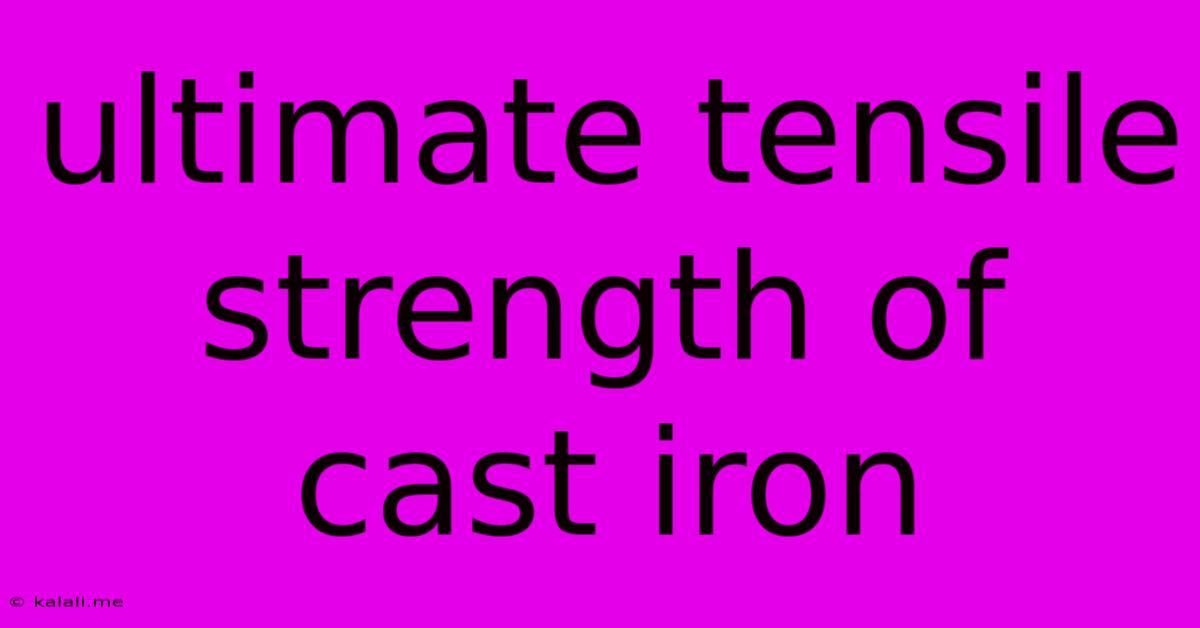Ultimate Tensile Strength Of Cast Iron
Kalali
Jun 14, 2025 · 4 min read

Table of Contents
Ultimate Tensile Strength of Cast Iron: A Comprehensive Guide
Meta Description: Discover the ultimate tensile strength of cast iron, its variations across grades, factors influencing strength, and applications where its unique properties are crucial. Learn about the limitations and why it's not ideal for tensile applications.
Cast iron, a widely used ferrous alloy, is known for its exceptional compressive strength, hardness, and wear resistance. However, its ultimate tensile strength is significantly lower compared to other materials like steel. Understanding this characteristic is crucial for selecting the right material for specific engineering applications. This article delves into the nuances of cast iron's tensile strength, exploring the factors that influence it and highlighting its limitations.
What is Ultimate Tensile Strength?
Before we delve into the specifics of cast iron, let's define ultimate tensile strength (UTS). UTS represents the maximum stress a material can withstand before it starts to fail or fracture when subjected to a tensile load. It's a critical parameter in material science and engineering, influencing design decisions and material selection. The UTS is determined through tensile testing, where a standardized specimen is subjected to a controlled tensile force until failure.
Ultimate Tensile Strength of Different Cast Iron Grades
The ultimate tensile strength of cast iron isn't a fixed value; it varies significantly depending on the grade and composition. Several factors influence this variation, including:
- Carbon Content: Higher carbon content generally leads to increased hardness and compressive strength but reduces ductility and tensile strength.
- Silicon Content: Silicon influences the graphite structure, affecting mechanical properties.
- Alloying Elements: The addition of elements like nickel, chromium, or molybdenum can alter the microstructure and mechanical properties, including tensile strength.
While precise values depend on the specific grade and manufacturing process, here's a general overview:
- Gray Iron: This is the most common type, characterized by flake graphite. Its UTS typically ranges from 180 to 350 MPa (26,000 to 51,000 psi).
- Ductile Iron (Nodular Iron): The addition of magnesium or cerium results in a nodular graphite structure, significantly improving ductility and tensile strength. Its UTS typically ranges from 345 to 620 MPa (50,000 to 90,000 psi).
- White Iron: This type has minimal graphite, resulting in high hardness and wear resistance, but very low ductility and tensile strength.
Factors Influencing Cast Iron's Tensile Strength
Beyond the grade, several factors can affect the ultimate tensile strength of a specific cast iron component:
- Casting Process: The casting method (e.g., sand casting, investment casting) influences the microstructure and resulting mechanical properties.
- Heat Treatment: Heat treatments can modify the microstructure, improving strength and other properties. However, heat treatment options are more limited for cast iron compared to steel.
- Cooling Rate: The rate at which the molten iron cools significantly impacts the final microstructure and strength.
- Internal Defects: Porosity, shrinkage cavities, and other casting defects can weaken the material and reduce its UTS.
Limitations of Cast Iron in Tensile Applications
Despite its other advantageous properties, the relatively low tensile strength of cast iron limits its applicability in situations requiring significant tensile loads. It's significantly less suitable for tensile applications than steel or other high-strength materials. This is primarily due to its brittle nature and the presence of graphite flakes or nodules which act as stress concentrators.
Applications Utilizing Cast Iron's Strength Properties
While not ideal for tensile loads, cast iron's high compressive strength, hardness, and wear resistance make it suitable for numerous applications:
- Engine Blocks and Cylinder Heads: The compressive strength is vital for withstanding the forces of combustion.
- Machine Bases: The rigidity and damping properties are beneficial for stable machine operation.
- Pipes and Fittings: Its ability to withstand internal pressure is crucial in various piping systems.
- Brake Drums and Rotors: Its wear resistance is essential for reliable braking performance.
Conclusion
The ultimate tensile strength of cast iron is a crucial consideration in material selection. Understanding the variations in UTS across different grades and the factors that influence this property is essential for engineers designing components that utilize cast iron. While its relatively low tensile strength limits its use in tension-dominated applications, its superior compressive strength and other properties make it a valuable material in many other engineering contexts. Always consult relevant material specifications and conduct appropriate testing to ensure the suitability of cast iron for any given application.
Latest Posts
Latest Posts
-
Which Of The Following Is A Monotreme
Jun 15, 2025
-
Which Plant Organelle Is Responsible For Photosynthesis
Jun 15, 2025
-
What Element Family Does Potassium Belong To
Jun 15, 2025
-
Lcm Of 5 10 And 15
Jun 15, 2025
-
How To Write 175 On A Check
Jun 15, 2025
Related Post
Thank you for visiting our website which covers about Ultimate Tensile Strength Of Cast Iron . We hope the information provided has been useful to you. Feel free to contact us if you have any questions or need further assistance. See you next time and don't miss to bookmark.